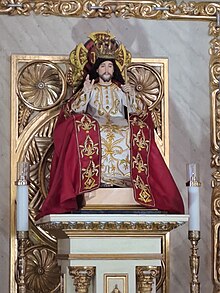
Back Slavnost Ježíše Krista Krále Czech Christkönigsfest German Solemnidad de Jesucristo, Rey del Universo Spanish Kristo erregearen egun Basque Tuomiosunnuntai Finnish Fête du Christ-Roi French Feest fan Kristus Kening Frisian חג ישו המלך HE Svetkovina Krista Kralja Croatian Krisztus király ünnepe Hungarian
| Solemnity of Our Lord Jesus Christ, King of the Universe | |
|---|---|
 | |
| Observed by | Catholic Church Lutheranism Anglican Communion[1] Methodist churches Moravian Church Church of the Nazarene Reformed churches Western Rite Orthodoxy[2] Other Christian denominations |
| Liturgical color | White |
| Observances | Church services Eucharistic adoration for a full day |
| Date | Last Sunday of the liturgical year; from 20–26 November, inclusive (in Ordinary Form),[3] or final Sunday of October (in Extraordinary Form) |
| 2024 date |
|
| 2025 date |
|
| 2026 date |
|
| 2027 date |
|
| First time | 31 October 1926 |
The Solemnity of Our Lord Jesus Christ, King of the Universe, commonly referred to as the Feast of Christ the King, Christ the King Sunday or Reign of Christ Sunday,[4] is a feast in the liturgical year which emphasises the true kingship of Christ. The feast is a relatively recent addition to the liturgical calendar, instituted in 1925 by Pope Pius XI for the Roman Rite of the Catholic Church. In 1970, its Roman Rite observance was moved from October to the last Sunday of Ordinary Time and thus to the end of the liturgical year. The earliest date on which the Feast of Christ the King can occur is 20 November and the latest is 26 November. It typically marks the end of Ordinary Time, which continues up until Advent Sunday, the first day of Advent. Depending on the year, Saint Andrew's Day, significant in some cultures, may fall prior to Advent Sunday. Thus, Christ the King is typically the last or second-to-last calendrical feast of the liturgical year.

The Lutheran, Anglican, Moravian, Methodist, Nazarene, Reformed and United Protestant churches also celebrate the Feast of Christ the King, which is contained in the Revised Common Lectionary;[5] the Methodist, Anglican and Presbyterian Churches often observe this as part of the liturgical season of Kingdomtide, which runs between the Fourth Sunday before Advent and the Feast of Christ the King. It is also observed on the same computed date as the final Sunday of the ecclesiastical year, the Sunday before the First Sunday of Advent, by Western Rite parishes of the Russian Orthodox Church Outside Russia.[6] Roman Catholics adhering to the Extraordinary Form of the Roman Rite use the General Roman Calendar of 1960 and continue to observe the Solemnity on the date established in 1925, the final Sunday of October.
- ^ The Feast of Christ the King, Archbishop Thabo Makgoba, anglicanchaurchsa, 21 November 2011
- ^ 29 October, Antiochian Western Rite Vicariate. https://www.orthodoxwest.com/kalendar
- ^ Richert, Scott P. (29 July 2018). "When Is the Feast of Christ the King?". Learn Religions. Retrieved 18 October 2020.
- ^ Cite error: The named reference
Moravian2012was invoked but never defined (see the help page). - ^ Revised Common Lectionary Daily Readings Proposed by the Consultation on Common Texts, Augsburg Fortress, 2005, pp. 304–305, ISBN 0806649305
- ^ Fraternity of St. Gregory the Great calendar